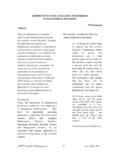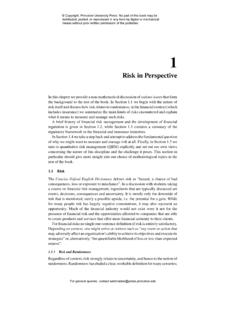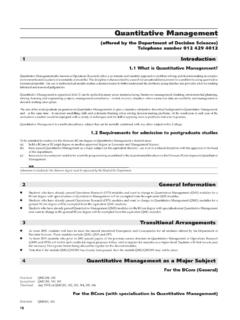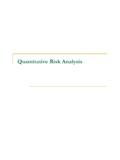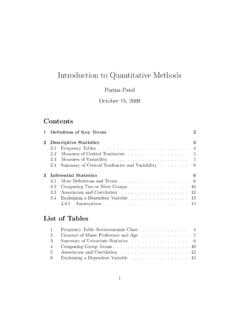Transcription of Chapter-1: QUANTITATIVE TECHNIQUES Self Assessment …
1 Chapter-1: QUANTITATIVE TECHNIQUES . self Assessment Questions 1. An operational definition is: a) One that bears no relation to the underlying concept b) An abstract, theoretical definition of a concept c) A definition of a concept in terms of specific, empirical measures d) One that refers to opera singers and their work 2. The general conclusion is that decisions are often only weakly based on evidence, either of the situation in question , or of the efficacy of the kind of intervention proposed (a) True (b) False 3. The difference between measures and indicators is that: a) Measures are unambiguous quantities, whereas indicators are devised from common sense understandings b) Indicators have a more direct relationship to the underlying concept than measures c) Measures are intuitively devised and then applied as if they were direct indicators of a concept d) Indicators are unambiguous quantities, whereas measures are subjective and value-laden 4.
2 The split-half method is used as a test of: a) Stability b) Internal reliability c) Inter-observer consistency d) External validity 5. Which of the following is not a form of measurement validity? a) Concurrent validity b) Face validity c) Conductive validity d) Convergent validity 6. QUANTITATIVE social researchers rarely claim to have established causality because: a) They are more concerned with publishing the results of their reliability tests b) They do not believe that this is an appropriate goal to be striving for c) They keep forgetting which of the variables they have manipulated d) They tend to use cross-sectional designs, which produce only correlations 7. The mathematical model is in the form of expressions and equations that replicate the problem. (a) True (b) False 8. QUANTITATIVE research has been criticised because: a) The measurement process suggests a spurious and artificial sense of accuracy b) The reliance on instruments and procedures makes it high in ecological validity c) It underestimates the similarities between objects in the natural and social worlds d) All of the above 9.
3 The term 'reverse operations' means that: a) The theories we devise will often hinder our attempts to measure concepts b) The measurements we devise can sometimes help to develop a theory c) TECHNIQUES such as factor analysis have no place in social research d) Driving instructors always make you practice the most difficult manoeuvre 10. Written accounts of QUANTITATIVE research rarely include the results of reliability and validity tests because: a) Researchers are more interested in reporting their operational definitions b) Researchers don't really think that these tests are important c) Journal editors have banned these kinds of articles d) Researchers are more interested in reporting their substantive findings 11. Which is the odd one out? Modern qualitative research can generally involve a detailed study of: a. psychological characteristics of interesting individuals. b. media content. c. conversational exchanges between people and interviews.
4 D. text. 12. An interest in qualitative methods has increased in terms of analysis of: a. laboratory experiments. b. categorizations. c. language based data. d. interest in qualitative is actually on the decline. 13. Qualitative research methods can be thought of as: a. methods used to search for the nature of reality. b. a stark alternative to QUANTITATIVE research. c. parallel with the physical sciences. d. a preliminary stage in the research which can contribute to the development of adequate quantification. 14. What term dominates the qualitative- QUANTITATIVE debate? a. Metaphysics. b. Critical realism. c. Positivism. d. Theism. 15. What is positivism? a. Positivism holds that knowledge is grounded in religion. b. Positivism refers to statistics and statistical analysis. c. Positivism is a philosophical position on how we go about obtaining knowledge. d. Positivism refers to knowledge about the nature of our being in the world as revealed through theoretical philosophizing.
5 16. Which of the following statements about the qualitative- QUANTITATIVE debate is incorrect? a. It became equated with relatively crude and quantified methods. b. Qualitative researchers often fail to recognize positivism as the epistemological basis of their work. c. Positivism applies to QUANTITATIVE methods. d. Positivism stresses the importance of observable and observed facts in the accumulation of knowledge. 17. Perhaps psychologists, more than some other disciplines, tend to do what? a. Have an allegiance to a theoretical empiricism (virtually the collection and analysis of data for its own sake). b. Still accept the view that "laws of psychology" are possible. c. No longer have the allegiance to the importance of observation. d. They write as if their statements concerning their research findings apply beyond the context in which they are studied. 18. QUANTITATIVE technique is not a scientific approach to managerial decision-making (a) True (b) False 19.
6 The importance of measurement in QUANTITATIVE research is that: a) It allows us to delineate fine differences between people or cases b) It provides a consistent device or yardstick c) It allows for precise estimates of the degree of relationship between concepts d) All of the above 20. One of the preoccupations of QUANTITATIVE researchers is with generalization, which is a sign of: a) External validity b) Internal reliability c) External reliability d) Internal validity Answers for self Assessment Questions 1. (a) 2.(a) 3.(a) 4.(b) 5.(c). 6. (d) 7.(a) 8.(a) 9.(b) 10.(d). 11. (a) 12.(c) 13.(d) 14.(c) 15.(c). 16. (c) 17.(d) 18.(b) 19.(d) 20.(a). Chapter-2: LINEAR PROGRAMMING. self Assessment Questions 1. What is the objective function (Z) to be maximized in this linear programming problem (where Z is total profit in s)? a) Z = 120X + 100Y. b) Z = 100X + 120Y. c) Z = 2X + 3Y. d) Z = 1500X + 1500Y. 2. Total profits are maximized when the objective function (as a straight line on a graph) is: a) Nearest to the origin and tangent to the feasible region'.
7 B) Furthest from the origin and tangent to the feasible region'. c) Furthest from the origin irrespective of the feasible region'. d) Nearest to the origin irrespective of the feasible region'. 3. What is the equation of the labour constraint line for the welding department in this linear programme? a) 2X + 3Y = 550 hours b) 3X + 2Y = 550 hours c) 2X + 3Y = 1,500 hours d) 3X + 2Y = 1,500 hours 4. What is the equation of the labour constraint line for the assembly department in this linear programme? a) 2X + 2Y = 1,500 hours b) 3X + 2Y = 1,500 hours c) 1X + 1Y = 1,500 hours d) 1X + 1Y = 550 hours 5. What is the solution to this linear programming problem in terms of the respective quantities of X and Y to be produced if profits are to be maximized? a) X = 400, Y = 150. b) X = 550, Y = 0. c) X = 0, Y = 500. d) X = 150, Y = 400. 6. Which of the following is NOT an assumption of linear programming? a) Diminishing returns to the variable factors of production b) Prices of products remain the same no matter how high the consumer demand c) Constant returns to the variable factors of production d) Prices of factor inputs remain the same no matter how high the firm demand 7.
8 What can we find by using the following formula? Total Fixed Costs Contribution per unit a) Break-Even Output b) Budgeted Profit c) Margin of Safety d) Budgeted Output 8 .Budgeted output minus break-even output gives us the: a) Budgeted Profit b) Contribution per unit c) Maximum profit solution d) Margin of Safety 9 .In break-even analysis we assume: a) Non-linear relationships b) Non-proportional relationships c) Diminishing returns to the variable factors of production d) Linear relationships 10 If each unit of output can be sold at a price of 5 and incurs variable costs which are constant at 3 per unit, and if the fixed costs already incurred are 15,000, then the break-even output is: a) 3,000 units b) 5,000 units c) 15,000 units d) 7,500 units 11. Unboundedness is usually a sign that the LP problem a) has finite multiple solutions. is degenerate. b) contains too many redundant constraints. c) has been formulated improperly. d) none of the above.
9 12. Which of the following is a property of all linear programming problems? a) alternate courses of action to choose from b) minimization of some objective c) a computer program d) usage of graphs in the solution e) usage of linear and nonlinear equations and inequalities 13. A point that satisfies all of a problem's constraints simultaneously is a(n). a) maximum profit point. b) corner point. c) intersection of the profit line and a constraint. d) None of the above 14. The first step in formulating an LP problem is a) graph the problem. b) perform a sensitivity analysis. c) identify the objective and the constraints. d) understand the managerial problem being faced. 15. LP theory states that the optimal solution to any problem will lie at the origin. a) a corner point of the feasible region. b) the highest point of the feasible region. c) the lowest point in the feasible region. d) none of the above 16. In order for a linear programming problem to have a unique solution, the solution must exist a) at the intersection of the non negativity constraints.
10 B) at the intersection of a non negativity constraint and a resource constraint. c) at the intersection of two or more constraints. d) none of the above 17. Consider the following linear programming problem: Maximize 12X + 10Y. Subject to: 4X + 3Y 480. 2X + 3Y 360 all variables 0. Which of the following points (X,Y) could be a feasible corner point? a) (40,48). b) (120,0). c) (180,120). d) none of the above 18. Consider the following linear programming problem: Maximize 12X + 10Y. Subject to: 4X + 3Y 480. 2X + 3Y 360 all variables 0. Which of the following points (X,Y) is feasible? a) (10,120). b) (120,10). c) (30,100). d) none of the above 19. Consider the following linear programming problem: Maximize 5X + 6Y. Subject to: 4X + 2Y 420. 1X + 2Y 120 all variables 0. Which of the following points (X,Y) is in the feasible region? a) (30,60). b) (105,0). c) (100,10). d) none of the above 20. Consider the following linear programming problem: Maximize 5X + 6Y.



